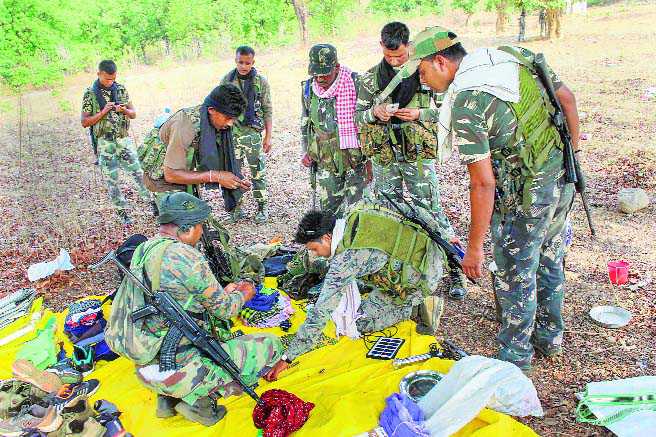
Lost Vigour: It is time for this new leadership to acknowledge that the democratic path of securing the rights is far more viable and beneficial than violence
Mallepalli Laxmaiah
Dalit Activist and Columnist
The Indian Maoist movement has had a recent change in leadership. Muppala Laxman Rao, better known as Ganapathy, hailing from Jagitial in old Karimnagar district of Telangana, has stepped down from leadership in favour of Namballa Keshava Rao, from Srikakulam district of Andhra Pradesh.
Both Srikakulam and Karimnagar were the main theatres of the Naxalite movement at its peak in the 1970s. While there are rumours that the change was due to ideological differences, it cannot be farther from the truth.
Ganapathy had stepped down owing to his advanced age and associated inability to continue as a leader of the armed movement. As such, there would be very little change in the ideological path and trajectory of the movement itself. Ganapathy had joined the movement in the erstwhile Karimnagar, which had seen outrageous caste discrimination and oppression while Keshava Rao had seen the plight of tribal life in Srikakulam district of north Andhra.
These problems were not addressed by the democratic system as it exists.
It can be argued in the present sense and context that an armed struggle against the state is not only futile but also detrimental to the cause that the movement itself stands for. To shed light on the Naxalite movement, it is important for us to examine the reason that caused its birth.
As India gained independence in 1947, the Constituent Assembly toiled under the able guidance of Dr Baba Saheb BR Ambedkar to lay a firm foundation for a democratic and egalitarian society. The Indian Constitution has been praised as being the most extensive one in the world, taking into consideration the diversity, economic and social disparity that existed for millennia in the subcontinent. If the Constitution were to be implemented in word and spirit, there would have been very little reason for agitation against the government.
However, this was not the case, as evidenced by the rise of Left extremist insurgencies like the Naxalite movement. The Naxalite movement started in 1967 in West Bengal as a response to the exploitation of tribals by landlords in Naxalbari. The lack of governance in deep forests and tribal areas led to the growth of the movement. It can be seen even today, that deep-set tribal areas in the hearts of Chhattisgarh and Srikakulam have a heavy presence of Naxalites or Maoists. The Communist parties in India, primarily the CPI and CPI(M), had focussed on the working class. The lowest strata of society consisting of Dalits and tribals, were ignored. The growing disparity brought forth another movement which was dubbed the CPI(ML), in other words, the Maoist movement. The Maoist movement, more popularly known as the Naxalite movement, had gained such traction claiming to represent the voice and action of the tribals and Dalits who were suffering due to neglect of the government.
It had always been clear that the armed movement gained strength in areas that were devoid of able governance. The lack of schooling, employment opportunities, medical aid and police network are still the reasons for the existence of the armed movement even now. Moreover, when the government seeks to privatise the forests for mining or any other associated economic activity, strong resistance is put up by the Naxalites whose stated intention is to protect the constitutional rights of the tribals. The resultant backfire from the armed forces of the state only puts the helpless tribals at risk. They are stuck between the police and the paramilitary forces on one hand, and Naxalites on the other.
It is time for this new and younger leadership to acknowledge that the democratic path of securing the rights of the tribals is far more viable and beneficial to the tribals than violence, force and use of arms. The state forces and Naxalites have for long been at loggerheads, preventing the initiation of a peaceful dialogue and resolution of pressing issues. The lack of basic amenities, besides being cut off from the outside world, has not helped the efforts of the state to annihilate the Naxalite movement.
Keshava Rao now faces the herculean task of defending his ever-shrinking territory due to reduced forests, increased police presence and most of all, gradual loss of support of the very people he had vowed to represent and defend.
It is pertinent to note that the ones who govern and exploit are closer to the people than the Naxalites, who are now being seen by the world as only extremists.
It can be seen that the areas from which both the leaders hail no longer have an active presence of this party. The movement, which had started in the plains for the benefit of the farm labourers and downtrodden, with the ideal and goal to overthrow the government with the aid of armed peasants, had to move away from those very people. The presence of arms justified police action. The movement, in order to mobilise an army, had spread across jungles in India, from Nepal to Andhra Pradesh, consisting of Bihar, Jharkhand, West Bengal, Madhya Pradesh, Orissa, Maharashtra, Andhra Pradesh and Telangana.
The party's influence is now limited to the forests of and around Chhattisgarh. Keshava Rao faces the incredible challenge of creating mass movements in other parts of India and expanding into the territories that are not any more under Maoist influence. It still stands to question whether under the leadership of Keshava Rao, Maoist party will see an ideological change or will continue on the present course.



























